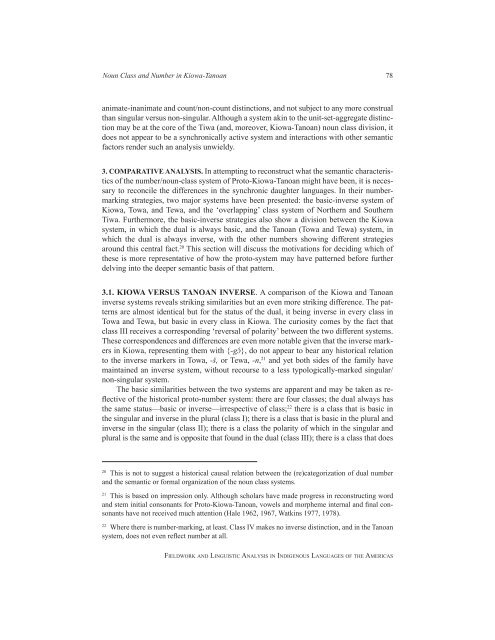Fieldwork and Linguistic Analysis in Indigenous ... - ScholarSpace
Fieldwork and Linguistic Analysis in Indigenous ... - ScholarSpace
Fieldwork and Linguistic Analysis in Indigenous ... - ScholarSpace
You also want an ePaper? Increase the reach of your titles
YUMPU automatically turns print PDFs into web optimized ePapers that Google loves.
Noun Class <strong>and</strong> Number <strong>in</strong> Kiowa-Tanoan 78<br />
animate-<strong>in</strong>animate <strong>and</strong> count/non-count dist<strong>in</strong>ctions, <strong>and</strong> not subject to any more construal<br />
than s<strong>in</strong>gular versus non-s<strong>in</strong>gular. Although a system ak<strong>in</strong> to the unit-set-aggregate dist<strong>in</strong>ction<br />
may be at the core of the Tiwa (<strong>and</strong>, moreover, Kiowa-Tanoan) noun class division, it<br />
does not appear to be a synchronically active system <strong>and</strong> <strong>in</strong>teractions with other semantic<br />
factors render such an analysis unwieldy.<br />
3. COMPARATIVE ANALYSIS. In attempt<strong>in</strong>g to reconstruct what the semantic characteristics<br />
of the number/noun-class system of Proto-Kiowa-Tanoan might have been, it is necessary<br />
to reconcile the differences <strong>in</strong> the synchronic daughter languages. In their numbermark<strong>in</strong>g<br />
strategies, two major systems have been presented: the basic-<strong>in</strong>verse system of<br />
Kiowa, Towa, <strong>and</strong> Tewa, <strong>and</strong> the ‘overlapp<strong>in</strong>g’ class system of Northern <strong>and</strong> Southern<br />
Tiwa. Furthermore, the basic-<strong>in</strong>verse strategies also show a division between the Kiowa<br />
system, <strong>in</strong> which the dual is always basic, <strong>and</strong> the Tanoan (Towa <strong>and</strong> Tewa) system, <strong>in</strong><br />
which the dual is always <strong>in</strong>verse, with the other numbers show<strong>in</strong>g different strategies<br />
around this central fact. 20 This section will discuss the motivations for decid<strong>in</strong>g which of<br />
these is more representative of how the proto-system may have patterned before further<br />
delv<strong>in</strong>g <strong>in</strong>to the deeper semantic basis of that pattern.<br />
3.1. KIOWA VERSUS TANOAN INVERSE. A comparison of the Kiowa <strong>and</strong> Tanoan<br />
<strong>in</strong>verse systems reveals strik<strong>in</strong>g similarities but an even more strik<strong>in</strong>g difference. The patterns<br />
are almost identical but for the status of the dual, it be<strong>in</strong>g <strong>in</strong>verse <strong>in</strong> every class <strong>in</strong><br />
Towa <strong>and</strong> Tewa, but basic <strong>in</strong> every class <strong>in</strong> Kiowa. The curiosity comes by the fact that<br />
class III receives a correspond<strong>in</strong>g ‘reversal of polarity’ between the two different systems.<br />
These correspondences <strong>and</strong> differences are even more notable given that the <strong>in</strong>verse markers<br />
<strong>in</strong> Kiowa, represent<strong>in</strong>g them with {-gɔ́}, do not appear to bear any historical relation<br />
to the <strong>in</strong>verse markers <strong>in</strong> Towa, -š, or Tewa, -n, 21 <strong>and</strong> yet both sides of the family have<br />
ma<strong>in</strong>ta<strong>in</strong>ed an <strong>in</strong>verse system, without recourse to a less typologically-marked s<strong>in</strong>gular/<br />
non-s<strong>in</strong>gular system.<br />
The basic similarities between the two systems are apparent <strong>and</strong> may be taken as reflective<br />
of the historical proto-number system: there are four classes; the dual always has<br />
the same status—basic or <strong>in</strong>verse—irrespective of class; 22 there is a class that is basic <strong>in</strong><br />
the s<strong>in</strong>gular <strong>and</strong> <strong>in</strong>verse <strong>in</strong> the plural (class I); there is a class that is basic <strong>in</strong> the plural <strong>and</strong><br />
<strong>in</strong>verse <strong>in</strong> the s<strong>in</strong>gular (class II); there is a class the polarity of which <strong>in</strong> the s<strong>in</strong>gular <strong>and</strong><br />
plural is the same <strong>and</strong> is opposite that found <strong>in</strong> the dual (class III); there is a class that does<br />
20 This is not to suggest a historical causal relation between the (re)categorization of dual number<br />
<strong>and</strong> the semantic or formal organization of the noun class systems.<br />
21 This is based on impression only. Although scholars have made progress <strong>in</strong> reconstruct<strong>in</strong>g word<br />
<strong>and</strong> stem <strong>in</strong>itial consonants for Proto-Kiowa-Tanoan, vowels <strong>and</strong> morpheme <strong>in</strong>ternal <strong>and</strong> f<strong>in</strong>al consonants<br />
have not received much attention (Hale 1962, 1967, Watk<strong>in</strong>s 1977, 1978).<br />
22 Where there is number-mark<strong>in</strong>g, at least. Class IV makes no <strong>in</strong>verse dist<strong>in</strong>ction, <strong>and</strong> <strong>in</strong> the Tanoan<br />
system, does not even reflect number at all.<br />
fieldwork <strong>and</strong> l<strong>in</strong>guistic analysis <strong>in</strong> <strong>in</strong>digenous languages of the americas

















